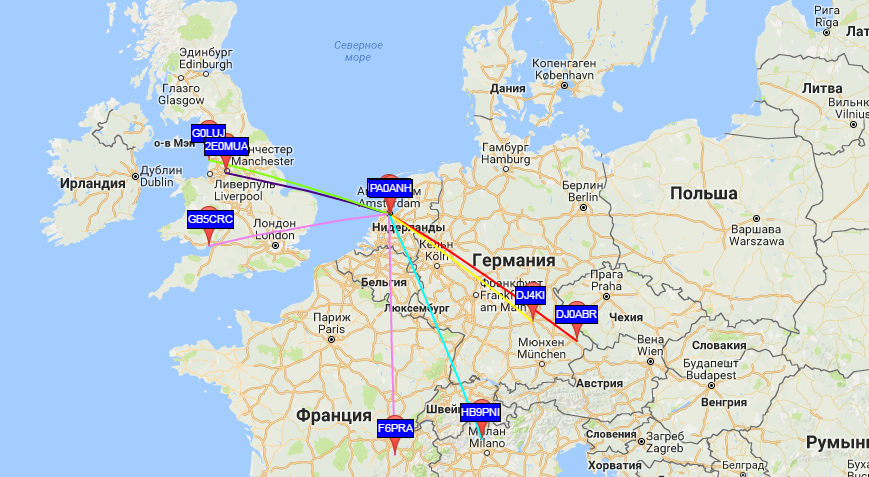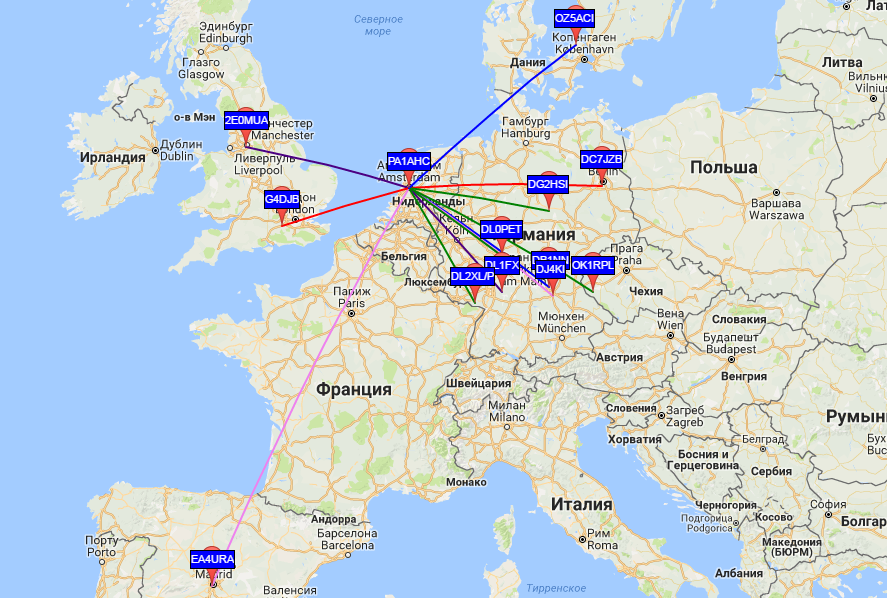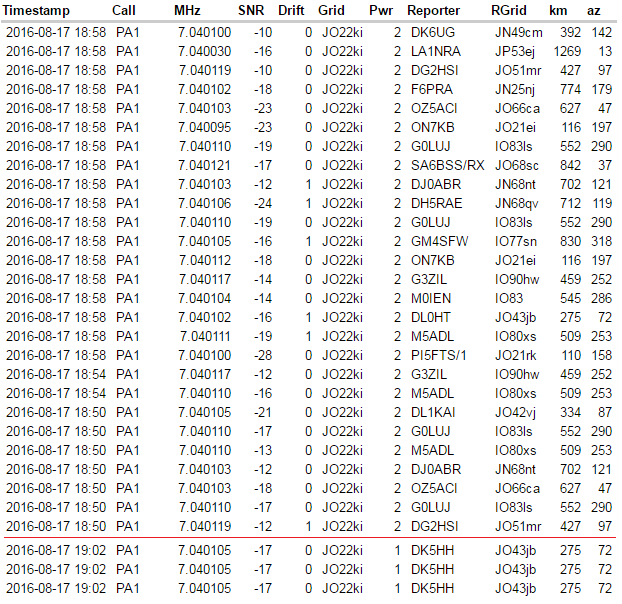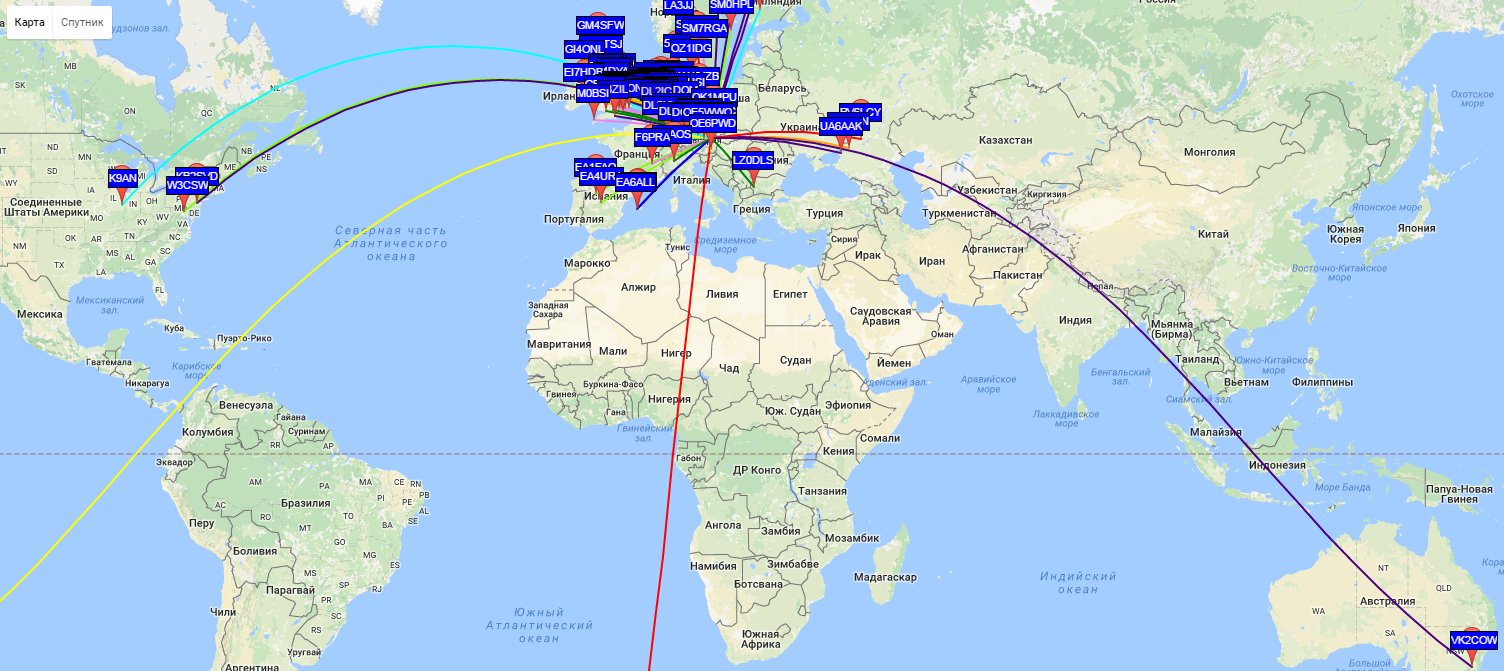A little about WSPR, or how far can you transmit a 1W signal?
Nowadays, a rise in interest in wireless technologies is noticeable, which is becoming especially relevant in the era of the “Internet of things”, “smart houses”, smart gadgets, various sensors and devices. Indeed, few people want to drill the wall and pull the wire to the temperature sensor outside the window, much easier if the data will be transmitted by radio. There are many solutions, for example, one of the latest developments is LoRa, the transmitters of this system are capable of transmitting data for several kilometers with a power of 10-100 MW.
How far can you transmit a radio signal? This is perhaps the most interesting question that was raised long before the term IoT appeared as such. Joseph Hooton Taylor, an American astrophysicist and a Nobel Prize winner, tried to answer the most complex question by creating the Weak Signal Propagation Reporter (WSPR) program in 2008. The idea of the program is simple - to transmit a signal that carries a minimum of information, which, due to this, can be decoded at the greatest possible distance.
How it works? Details under the cut. As it turned out, WSPR was never described on geektimes, it's time to fill this gap.
WSPR is as simple as a digital signal transmitted at a rate of only 1.4648 baud (yes, only slightly more than 1 bit per second). Frequency modulation (4-FSK) with a frequency separation of 1.4648 Hz is used for transmission, so the signal bandwidth is only 6 Hz. The transmitted data packet has a size of only 50 bits, error correction bits are also added to it (non-recursive convolutional code, constraint length K = 32, rate = 1/2), as a result, the total packet size is 162 bits. These 162bits are transmitted in about 2 minutes (someone else will complain about slow internet? :).
')
The 50-bit packet itself contains a minimum set of data sufficient for use by amateur stations: the call station of the transmitting station, the square of the station's location (the so-called grid locator), and the signal power. A more complete description, including distributions under Win / MacOS and Linux, as well as the source code of the program for reception and transmission, are available at http://physics.princeton.edu/pulsar/k1jt/wspr.html .
Thanks to the narrowband signal, the system was very sensitive. The minimum signal-to-noise level for decoding is –28 dB, which exceeds even the reception of Morse code by a trained operator. And finally, the most interesting thing is that the site http://wsprnet.org was created, where the received data is automatically sent, and anyone (including the station owner or the receiving signal) can view the statistics and visualization on the received data map.
To receive WSPR signals, it is enough to have a receiver with the possibility of receiving single-band modulation (Tescun PL-660, Sangean ATS-909x, Sony ICF-SW7600, etc.). Using WSPR is quite simple - just connect the receiver to the line input of the sound card and select it as a signal source in the program. Next, in the settings, you must specify the location in the form of grid locator, which can be found on the site https://www.qrz.com/gridmapper . You can use the original version of WSPR, but it is better to use a newer WSJT , whose interface is more convenient.
At this almost all the settings are finished. You need to set the receiver to the selected frequency (the list of frequencies can be viewed on the website ), turn on the program, and you can go and have tea. After 15 minutes, you can check the program window, which should look like this:

If the program has entered the call station of the receiving station and the “Upload to server” checkbox has been selected, then go to http://wsprnet.org/drupal/wsprnet/map and enter this call sign, you can see the receiving graphic card, and by going to http : //wsprnet.org/drupal/wsprnet/spots , you can see more detailed text information.
For transmission, an amateur radio transceiver (for example, Yaesu 857) and a radio amateur license (upon receipt of which the station's call sign is issued) are also required. The wspr server does not verify the correctness of licenses and callsigns, the station owner solves this issue on his own.
Otherwise, the principle is the same: the radio station is connected to the computer, the signal is formed through the sound card. Each session lasts 2 minutes, after some time you can go to the site and see the statistics.
To check, I asked a friend with an appropriate transceiver to do 3 tests:
1) Reception of signals at a frequency of 7.038 MHz to a random antenna (piece of wire).
2) Reception of signals at the same frequency to the tuned antenna.
3) Signal transmission
This is the most inefficient method in terms of reception quality. The signal level is minimal, and the antenna also receives a lot of noise from household appliances. The program was launched for about 15 minutes, the result was immediately visible as a map on the site:

The maximum reception distance was about 700 km, which in principle is not so bad.
A magnetic loop antenna tuned to the same frequency was tested next. The magnetic loop antenna is practically the only antenna capable of working both for reception and transmission, which can be placed in an apartment, its size is 1-2m.
The result of the program in 10 minutes:

The difference is obvious - in less time, more stations were received, and the maximum reception distance was about twice as long.
It is interesting to analyze the results in textual form:

The red line was the time to switch one antenna to another. It can be seen that at a transmission power of 1 watt, the average reception distance to the indoor antenna is about 500 km. The result is 1488km at a power of 0.1W, but we don’t know if this is true - unfortunately, the program does not check the values entered by the user (you can specify 1W and transmit to 100W, it is impossible to check this), maybe that operator simply made a mistake when entering the parameters.
Finally, the last test was the transmission of a signal from the same room antenna. Transmitted power was selected at 1 and 2W. The results are shown on the map and in the table:


As you can see, the range at a power of 1W was 275km, only one operator received the signal. At 2W, the picture is already more interesting - the maximum range was as much as 1200 km.
Of course, indoor antennas in urban environments are very imperfect in efficiency. Outside the city, in conditions of pure air with a minimum amount of interference, one can receive much weaker signals.
As you can see, wspr is a very interesting tool that allows you to visually study the passage of radio waves and compare the quality of antennas. It is also interesting that the whole system works at the expense of enthusiasts and the community, someone transmits signals, someone accepts, and at the expense of a large number of participants, the results are very interesting and visual.
Returning to the question of the header, how far can you transmit data with 1 Watt of power. Far enough, as the search in the base of the site shows, by the example of a radio amateur with the call sign OE3MUC. Here is his 1W transmission card:

Of course, it’s also a matter of having good and high-quality directional antennas, but, nevertheless, it’s very interesting - with a power of only 1W (i.e., hypothetically, such a transmitter can be powered directly from the USB connector), you can transfer without any Internet connections and cables data across the ocean from Austria to Australia at 15000km. There is something to think about ...
How far can you transmit a radio signal? This is perhaps the most interesting question that was raised long before the term IoT appeared as such. Joseph Hooton Taylor, an American astrophysicist and a Nobel Prize winner, tried to answer the most complex question by creating the Weak Signal Propagation Reporter (WSPR) program in 2008. The idea of the program is simple - to transmit a signal that carries a minimum of information, which, due to this, can be decoded at the greatest possible distance.
How it works? Details under the cut. As it turned out, WSPR was never described on geektimes, it's time to fill this gap.
Signal structure
WSPR is as simple as a digital signal transmitted at a rate of only 1.4648 baud (yes, only slightly more than 1 bit per second). Frequency modulation (4-FSK) with a frequency separation of 1.4648 Hz is used for transmission, so the signal bandwidth is only 6 Hz. The transmitted data packet has a size of only 50 bits, error correction bits are also added to it (non-recursive convolutional code, constraint length K = 32, rate = 1/2), as a result, the total packet size is 162 bits. These 162bits are transmitted in about 2 minutes (someone else will complain about slow internet? :).
')
The 50-bit packet itself contains a minimum set of data sufficient for use by amateur stations: the call station of the transmitting station, the square of the station's location (the so-called grid locator), and the signal power. A more complete description, including distributions under Win / MacOS and Linux, as well as the source code of the program for reception and transmission, are available at http://physics.princeton.edu/pulsar/k1jt/wspr.html .
Thanks to the narrowband signal, the system was very sensitive. The minimum signal-to-noise level for decoding is –28 dB, which exceeds even the reception of Morse code by a trained operator. And finally, the most interesting thing is that the site http://wsprnet.org was created, where the received data is automatically sent, and anyone (including the station owner or the receiving signal) can view the statistics and visualization on the received data map.
Use for reception
To receive WSPR signals, it is enough to have a receiver with the possibility of receiving single-band modulation (Tescun PL-660, Sangean ATS-909x, Sony ICF-SW7600, etc.). Using WSPR is quite simple - just connect the receiver to the line input of the sound card and select it as a signal source in the program. Next, in the settings, you must specify the location in the form of grid locator, which can be found on the site https://www.qrz.com/gridmapper . You can use the original version of WSPR, but it is better to use a newer WSJT , whose interface is more convenient.
At this almost all the settings are finished. You need to set the receiver to the selected frequency (the list of frequencies can be viewed on the website ), turn on the program, and you can go and have tea. After 15 minutes, you can check the program window, which should look like this:

If the program has entered the call station of the receiving station and the “Upload to server” checkbox has been selected, then go to http://wsprnet.org/drupal/wsprnet/map and enter this call sign, you can see the receiving graphic card, and by going to http : //wsprnet.org/drupal/wsprnet/spots , you can see more detailed text information.
Use for transfer
For transmission, an amateur radio transceiver (for example, Yaesu 857) and a radio amateur license (upon receipt of which the station's call sign is issued) are also required. The wspr server does not verify the correctness of licenses and callsigns, the station owner solves this issue on his own.
Otherwise, the principle is the same: the radio station is connected to the computer, the signal is formed through the sound card. Each session lasts 2 minutes, after some time you can go to the site and see the statistics.
results
To check, I asked a friend with an appropriate transceiver to do 3 tests:
1) Reception of signals at a frequency of 7.038 MHz to a random antenna (piece of wire).
2) Reception of signals at the same frequency to the tuned antenna.
3) Signal transmission
Admission to a random antenna
This is the most inefficient method in terms of reception quality. The signal level is minimal, and the antenna also receives a lot of noise from household appliances. The program was launched for about 15 minutes, the result was immediately visible as a map on the site:

The maximum reception distance was about 700 km, which in principle is not so bad.
Reception on a tuned antenna
A magnetic loop antenna tuned to the same frequency was tested next. The magnetic loop antenna is practically the only antenna capable of working both for reception and transmission, which can be placed in an apartment, its size is 1-2m.
The result of the program in 10 minutes:

The difference is obvious - in less time, more stations were received, and the maximum reception distance was about twice as long.
It is interesting to analyze the results in textual form:

The red line was the time to switch one antenna to another. It can be seen that at a transmission power of 1 watt, the average reception distance to the indoor antenna is about 500 km. The result is 1488km at a power of 0.1W, but we don’t know if this is true - unfortunately, the program does not check the values entered by the user (you can specify 1W and transmit to 100W, it is impossible to check this), maybe that operator simply made a mistake when entering the parameters.
Signal transmission
Finally, the last test was the transmission of a signal from the same room antenna. Transmitted power was selected at 1 and 2W. The results are shown on the map and in the table:


As you can see, the range at a power of 1W was 275km, only one operator received the signal. At 2W, the picture is already more interesting - the maximum range was as much as 1200 km.
Of course, indoor antennas in urban environments are very imperfect in efficiency. Outside the city, in conditions of pure air with a minimum amount of interference, one can receive much weaker signals.
Conclusion
As you can see, wspr is a very interesting tool that allows you to visually study the passage of radio waves and compare the quality of antennas. It is also interesting that the whole system works at the expense of enthusiasts and the community, someone transmits signals, someone accepts, and at the expense of a large number of participants, the results are very interesting and visual.
Returning to the question of the header, how far can you transmit data with 1 Watt of power. Far enough, as the search in the base of the site shows, by the example of a radio amateur with the call sign OE3MUC. Here is his 1W transmission card:

Of course, it’s also a matter of having good and high-quality directional antennas, but, nevertheless, it’s very interesting - with a power of only 1W (i.e., hypothetically, such a transmitter can be powered directly from the USB connector), you can transfer without any Internet connections and cables data across the ocean from Austria to Australia at 15000km. There is something to think about ...
Source: https://habr.com/ru/post/369589/
All Articles